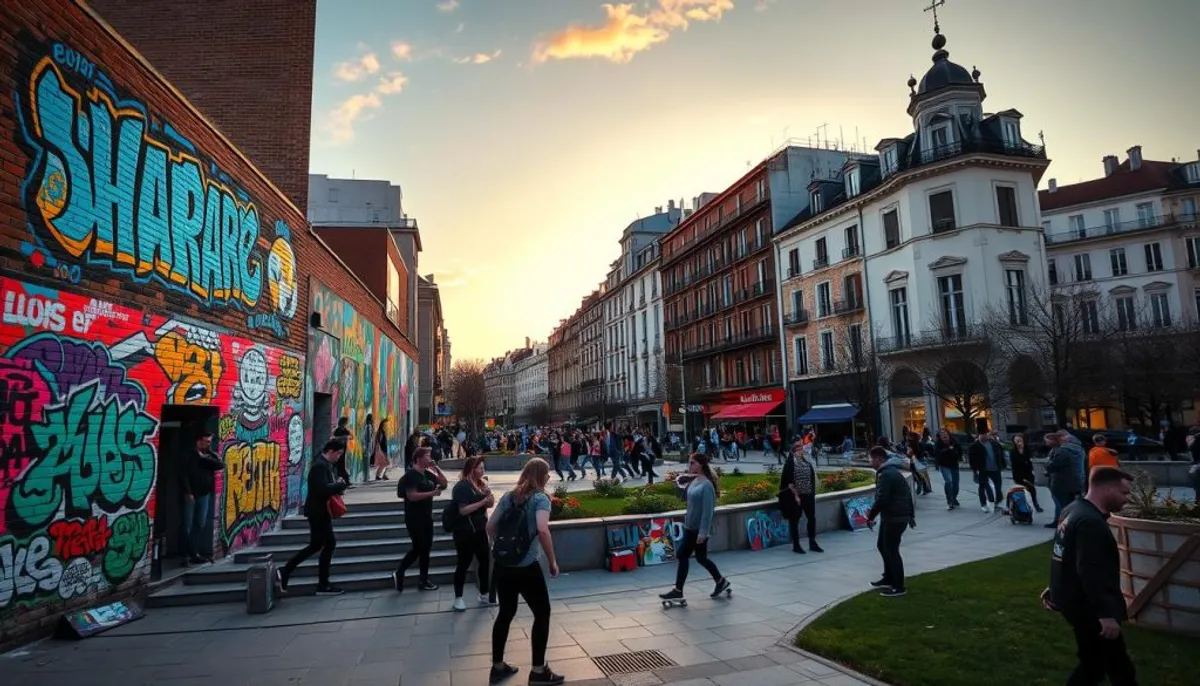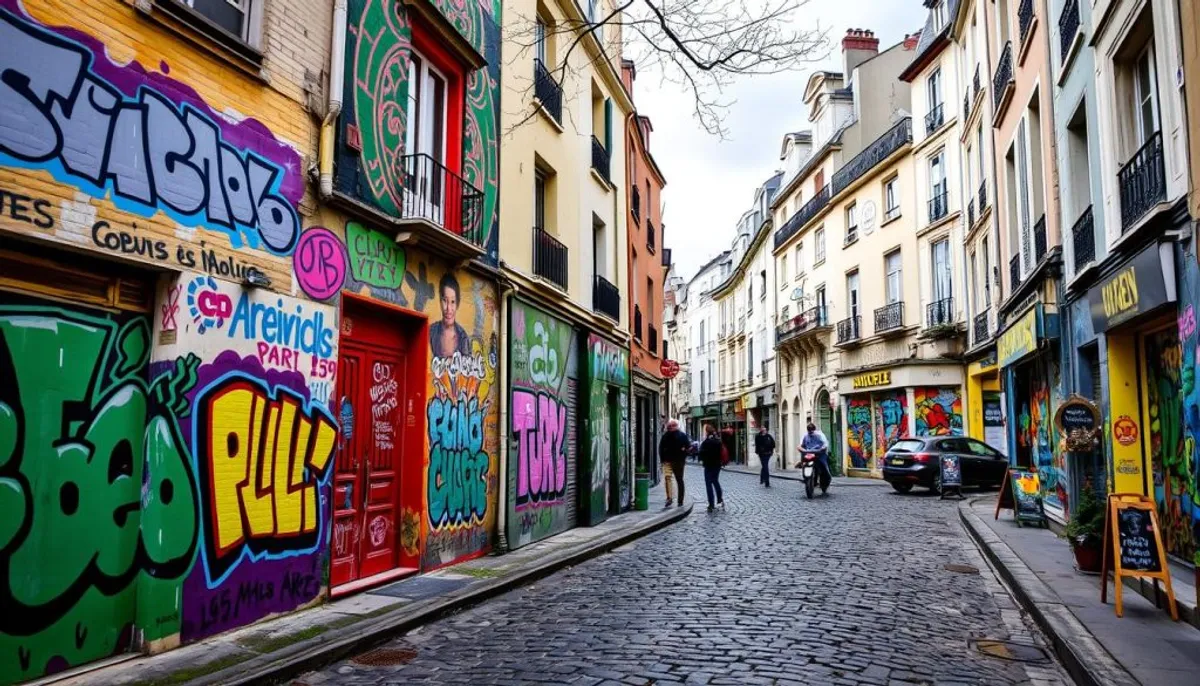The urban culture in France, which emerged in the 1980s, is a dynamic phenomenon. It includes various forms of art born in urban streets. From rap to street art, as well as dance and sports, it reflects the creativity and energy of urban youth.
French urban art, resulting from a fusion of American influences and local sensibilities, has developed as a unique expression. Seine-Saint-Denis, the birthplace of this movement, is a major hub of hip-hop culture. It regularly hosts festivals that celebrate this form of art.

In 2021, the Philharmonie de Paris recognized the importance of this movement by dedicating a major exhibition to hip-hop. This institutional recognition reflects the profound impact of urban culture on contemporary French society.
Cities like Bagnolet, Montreuil, and Saint-Ouen have become must-visit destinations for street art enthusiasts. These places, along with numerous annual festivals, provide spaces for urban artists to express themselves. They contribute to the constant evolution of this dynamic scene.
The Emergence of Urban Culture in France
In the 1980s, French urban culture took off, influenced by the American hip-hop movement. This new artistic expression established itself in the Hexagon, especially in the Parisian suburbs.
From American Origins to French Adaptation
French hip-hop adapted local realities while maintaining the original spirit of the movement. Artists created a unique style, merging American influences with French culture. This fusion has led to a dynamic and original artistic scene.
The Impact of the 1980s on the Urban Scene
The 1980s were a major turning point for urban culture in France. This period saw the emergence of key artists for French hip-hop. The cultural policies of the time facilitated access to cultural goods, promoting the development of this new expression.
Seine-Saint-Denis: Cradle of the Movement
Seine-Saint-Denis has become the heart of French urban culture. This department in the Parisian suburbs, with its urban density and social diversity, is a true artistic breeding ground. Many artists have found inspiration and means of expression there.
| Characteristic | Impact on Urban Culture |
|---|---|
| Urban density | Facilitates artistic encounters and exchanges |
| Social diversity | Enriches influences and styles |
| Large housing complexes | Provide spaces for street art expression |
Today, French urban culture continues to evolve while staying true to its roots. Events like the Urban Cultures Week testify to its vitality and diversity, encompassing rap, graffiti, dance, and urban sports.
The Foundations of Urban Culture
Urban culture in France is built on essential pillars that shape its unique identity. It finds strength in collective creativity, expresses itself in public spaces, and embodies a form of urban resistance. These elements contribute to forging a distinctive cultural identity at the heart of French cities.
Sharing and Collective Creativity
At the heart of urban culture lies the notion of sharing. Artists and enthusiasts collaborate, exchange ideas, and create together. This collective creativity gives rise to innovative works that reflect the diversity and richness of urban communities, particularly through contemporary dance in Lyon.

Expression in Public Space
Public space plays a crucial role in urban culture. The street becomes a giant canvas where artists express themselves freely. Graffiti, street performances, and ephemeral installations transform the city into an open-air museum, accessible to all.
Resistance and Cultural Identity
Urban culture embodies a form of resistance against established norms. It allows communities to assert their cultural identity and take ownership of their environment. This urban resistance manifests through art, music, and fashion, creating a strong sense of belonging.
| Element | Characteristic | Impact |
|---|---|---|
| Collective creativity | Artistic collaboration | Cultural innovation |
| Public space | Place of free expression | Democratization of art |
| Urban resistance | Identity claim | Social cohesion |
These foundations of urban culture in France contribute to its dynamism and constant evolution. They allow younger generations to express themselves, create, and shape their own cultural identity within urban spaces.
The Major Artistic Disciplines
French urban culture is rich and diverse, with unique artistic disciplines. Hip-hop, the foundation of this movement, encompasses several forms of expression. These artistic expressions have transformed the streets and captured the hearts of the French.
French rap, emerging in the 1980s, has become the voice of the neighborhoods. It exposes the social realities, hopes, and challenges of urban youth. Emerging artists, including talented women, continue to enrich this music scene.
Urban dance, including breakdancing, popping, and locking, transforms sidewalks into performance stages. These energetic and expressive dances attract a wide range of ages, creating bridges between generations.
Graffiti, a rebellious art form, colors the walls of French cities. From Bagnolet to Saint-Ouen, via Montreuil, these ephemeral works tell the stories of neighborhoods and their inhabitants.
Slam and beatboxing complement this rich and varied artistic landscape. Each offers a unique opportunity for expression and creativity in public space.
| Discipline | Characteristics | Social Impact |
|---|---|---|
| French rap | Engaged lyrics, reflection of social realities | Voice of neighborhoods, vector of expression |
| Urban dance | Varied styles (breakdance, popping, locking) | Intergenerational link, bodily expression |
| Graffiti | Visual art in public space | Transformation of neighborhoods, visual storytelling |
| Slam/Beatbox | Oral performance, vocal rhythm | Language creativity, accessible performance |
Street Art: Between Rebellion and Recognition
French street art has undergone a significant transformation, moving from obscurity to notoriety. Originating from the streets, it has established itself as a legitimate form of expression. Its evolution reflects the social and cultural transformations of our time.
The Territories of French Street Art
Seine-Saint-Denis is recognized as the cradle of street art in France. Cities like Bagnolet, Montreuil, and Saint-Ouen have seen their streets transformed into art galleries. The Canal de l'Ourcq and the Oberkampf-Ménilmontant district attract urban art enthusiasts from around the world.

The Major Festivals and Events
Urban art festivals have played a crucial role in the recognition of street art. The Street Art Fest Grenoble-Alpes, for example, highlights contemporary artists. These events strengthen the ties between art and local communities, attracting a varied and curious audience.
The Professionalization of the Movement
The professionalization of French street art is a reality. Specialized galleries like Lacroix or Wallworks in the eastern Paris area now exhibit the works of urban artists. This evolution has opened new opportunities for creators, sparking debates about the commercialization of this art born in the streets.
| Year | Event | Impact |
|---|---|---|
| 2013 | Street Art Market in Great Britain | 300 million euros generated |
| 2014 | Confrontation M. CHAT vs RATP | Debate on the legality of urban art |
| 2016 | Commission from the City Hall of Reims to C215 | Institutional recognition |
French street art continues to evolve, adapting to new technologies and societal issues. Social media provides artists with a global platform to share their works. This enhances the reach and impact of this ever-changing urban art.
Urban Culture and its Social Values
Urban culture represents fundamental values that shape our society. It values individuality while promoting social inclusion. This unique artistic expression finds its origins in working-class neighborhoods, but its influence far exceeds these boundaries.
It is rooted in essential principles such as sharing, respect, and community life. These values guide artists and enthusiasts toward authenticity. Urban art becomes a powerful tool for social and political communication, transforming public spaces into true open-air galleries.
The impact of urban culture on society is undeniable. It has gained a wide audience, as shown by streaming music figures. In 2018, more than half of the 20 most listened-to albums in France were of the urban genre. This growing popularity reflects the public's adherence to the values of this movement.
Urban culture plays a crucial role in social inclusion. It provides a platform for expression to often marginalized voices, allowing everyone to share their story and origins. This diversity enriches our social fabric and fosters mutual understanding within the community.
In conclusion, urban culture transcends the artistic framework. It embodies a way of life and a philosophy that values creativity, authenticity, and solidarity. Its growing influence testifies to its ability to respond to the aspirations of our modern society.
Spaces for Expression and Creation
Urban culture in France thrives in a diversity of urban cultural venues. These spaces offer artists and the public unique opportunities for expression and encounter.
Iconic Places
Paris and its suburbs host a multitude of places dedicated to urban cultures. Wip Villette, located in the Parc de la Villette, is a focal point for urban artists. In Bobigny, Canal 93 stands out as a legendary venue for contemporary urban music. Café la Pêche in Montreuil is known for promoting young rap talents.
New Infrastructures
Artistic infrastructures are evolving to meet the needs of the urban scene. L'Embarcadère in Aubervilliers and the Cultural Café in Saint-Denis illustrate this trend. Venues like Glazart, Mains d'œuvres, and Cabaret Sauvage regularly host urban culture events, contributing to the vitality of the scene.
Creative Neighborhoods
Creative neighborhoods are emerging as attractions for urban artists. These urban areas transformed by art become places of life and experimentation. The Fête de la Musique, extending to over 110 countries, exemplifies how urban cultural phenomena can reshape public space, giving it a positive connotation and fostering territorial cohesion.
These spaces for expression play a crucial role in urban development. They influence city planning, with the creation of new artistic infrastructures such as performance venues or urban furniture. Municipal cultural policies, rooted in a long tradition, continue to support these initiatives, recognizing their impact on territorial dynamics and social ties.
The Evolution of Urban Style and Fashion
French streetwear is at the heart of urban culture. It finds its origins in the skate and surf cultures of California in the 1980s. The New York hip-hop scene later adopted it. Over time, it has fused high fashion and popular culture.
French Streetwear
In France, streetwear has created a unique identity. Local brands have adapted American codes to French aesthetics. Thus, sneakers, oversized sweatshirts, ripped jeans, and caps have become essentials.
The Influence on Contemporary Fashion
The impact of streetwear on current fashion is profound. Major fashion houses now incorporate urban elements into their collections. This fusion creates a unique blend of luxury and casual.
Brands and Collaborations
Collaborations between urban artists and major brands are common. These partnerships create unique pieces, blending tradition and street. These creations can be found in places like the Malik market or the Clignancourt-Saint-Ouen flea market.
Streetwear is more than just a trend. It is an evolving movement, reflecting our culture and society. It represents a lifestyle, an attitude, and a style, combining comfort and character.
Conclusion
Urban culture in France has undergone a significant artistic transformation. It has moved from an underground movement to a dominant cultural phenomenon. Its influence is felt in art, music, and fashion, shaping the urban identity of several cities. The future of this urban culture promises to be even more impactful, profoundly influencing our society.
Data shows a revolution in the planning of urban spaces. The relocation of the National Museum of Arts and Popular Traditions to Marseille in 2009 is an example of this evolution. Local authorities have also invested in creating skateparks, integrating urban culture into urban planning. This has created new specialized job opportunities.
Street art, once seen as a form of rebellion, is now recognized. Festivals and events dedicated to this art are multiplying, attracting a diverse audience. They also contribute to the local economy. This artistic evolution demonstrates the adaptability and innovation of French urban culture.
In summary, the future of urban culture in France is promising and influential. Its impact on art, society, and the economy will continue to expand. French urban culture, in constant evolution, offers a fascinating reflection of our contemporary society.
RelatedRelated articles


